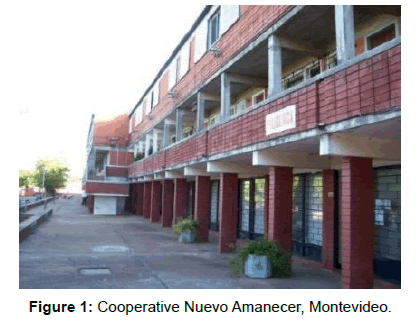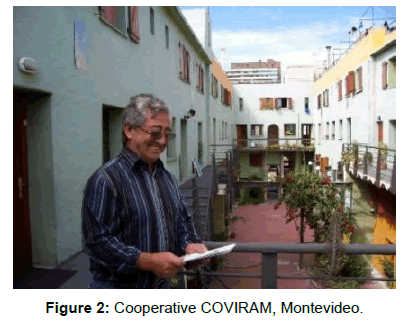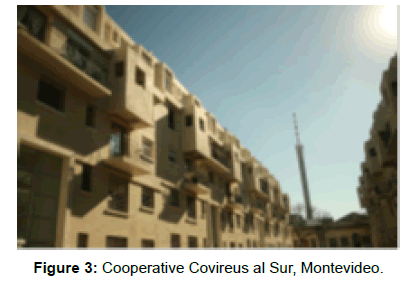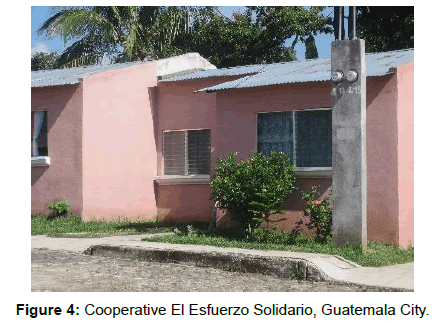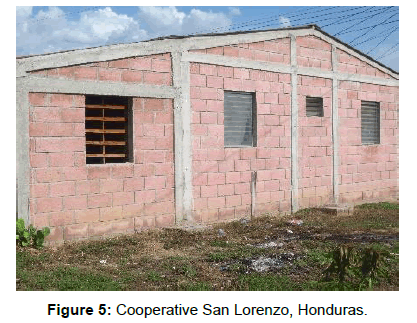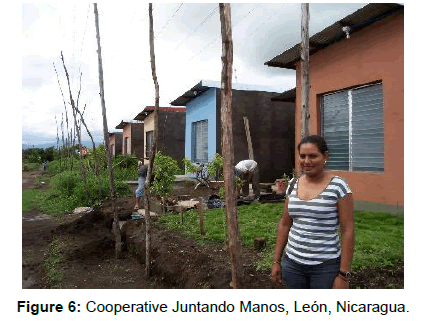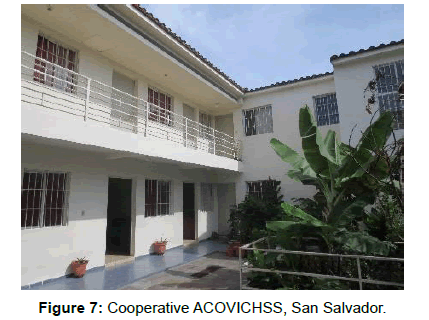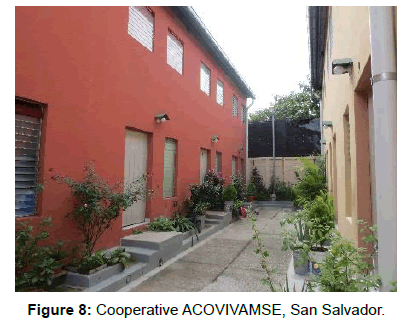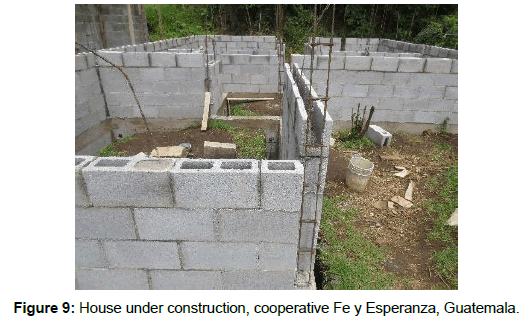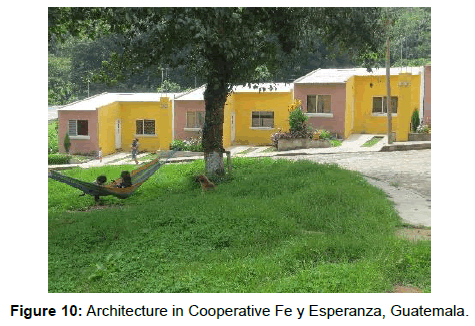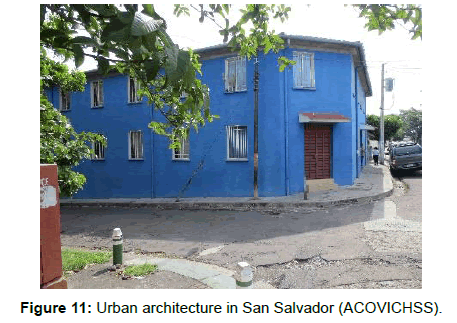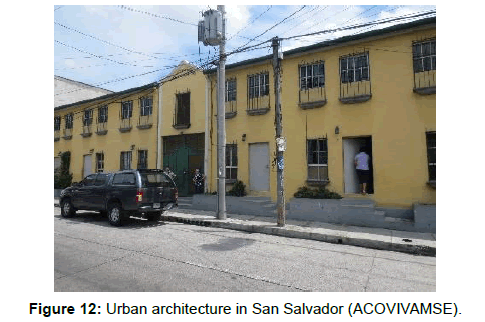Research Article Open Access
Self-Managed Cooperative Housing by Mutual- Assistance as Introduced in Central America between 2004 and 2016; the Attractiveness of the ‘FUCVAM’ Model of Uruguay
Jan Bredenoord*
International Urban Planner/Housing Researcher, Amerikaring 26, 3823 HT Amersfoort, The Netherlands
- *Corresponding Author:
- Jan Bredenoord
International Urban Planner/Housing Researcher
Amerikaring 26, 3823 HT Amersfoort
The Netherlands
Tel: +31 6 22446251
E-mail: janbredenoord@planet.nl
Received Date: March 03, 2017; Accepted Date: March 16, 2017; Published Date: March 24, 2017
Citation: Bredenoord J (2017) Self-Managed Cooperative Housing by Mutual- Assistance as Introduced in Central America between 2004 and 2016; the Attractiveness of the ‘FUCVAM’ Model of Uruguay. J Archit Eng Tech 6: 188. doi: 10.4172/2168-9717.1000188
Copyright: © 2017 Bredenoord J. This is an open-access article distributed under the terms of the Creative Commons Attribution License, which permits unrestricted use, distribution, and reproduction in any medium, provided the original author and source are credited.
Visit for more related articles at Journal of Architectural Engineering Technology
Abstract
This paper discusses the importance of cooperative housing through mutual assistance and collective ownership in Latin America. Cooperative housing is a form of self-managed house building, which is of great importance for a growing number of low-income households. It makes possible the access to appropriate housing for families with lowincomes, that don’t have other possibilities.The mutual self-managed cooperative housing model of the Uruguayan federation of housing cooperatives ‘FUCVAM’ offers a more effective alternative to individual, incremental self-help or self-managed housing that is still is prevalent in many countries, including in Latin America. Since 2004, the model has been implemented with the help of the NGO We Effect in seven Latin American countries: Guatemala, Honduras, Nicaragua, El Salvador, Costa Rica, Bolivia and Paraguay. The author investigated the development of 22 cooperatives in four Central American countries in mid-2016, and his findings are presented in this paper. The members of the cooperative are intensively involved in the construction process and activities, in order to lower the construction costs, while the houses are being constructed durably under professional supervision.
Keywords
Housing cooperatives; Cooperative housing; Housing cooperatives with mutual assistance; The FUCVAM cooperative model; Cooperative housing movement; Housing research
Introduction
The housing cooperatives in developing countries are useful tools for the social production of affordable housing [1]. Housing cooperatives can facilitate two types of production of social housing, namely 1) individual self-help or self-managed housing, which is still relevant in many countries, and 2) social housing projects, which are increasingly common. The first production form is individual in nature, while the second form is collective in nature. In the second form, the inhabitants are ‘housing consumers’ and try to obtain a property within a wide range of subsidized housing projects. The public involvement in both systems covers – or should cover – infrastructure facilities, technical assistance, access to land, formalization of landownership, and housing finance through grants and loans. The search for financial help from governments and other sources has been crucial in We Effect’s work. When it comes to new house construction or urban renewal, local governments and the utilities usually are involved in spatial planning and the creation of roads, water works, electricity supply, etc. However, in many developing countries, individual family self-help housing is still the only possibility that poor people have for housing. In the Global South, individual self-help or self-managed housing accounts for 50% and 90% of the housing stock [2]. Many families build and improve their houses over the course of years, and gradually they make use of the possibility to rent out rooms to others, to acquire income for their family. The practice of self-help housing is therefore often interwoven with the rental segment of the housing market. This is of social importance because it is precisely in those areas where the formal production of social rental houses is very limited or even absent, which is a major problem in many growing cities. Incremental self-help housing has both advantages and disadvantages. Seen from the perspective of the residents, self-help housing means that:
a) Households can decide when the home will be improved;
b) Savings are used for improvements;
c) Small loans are sought for home improvements; and
d) Help is sought from family members, friends, etc.
From the perspective of the local government, there are often concerns about the quality of the self-built homes and extensions, as well as the long duration of the construction processes. There is often a complete or partial lack of adequate municipal building codes, supervision on the construction sites, and financial and technical assistance for the residents. Improved building codes can make a significant difference in the rate of building collapses in fast-changing environments. This is what the World Bank promotes in its Building Regulation for Resilience program. Advisory activities should give priority to providing outreach services to informal sector builders in order to increase access to the benefits of the building safety and regulatory processes [3]. Additionally to the housing issues, the vision of adding economic activities to the cooperatives is important in order to help those starting economic activities for those who don’t have a job and for food sovereignty. Therefore, one can find a number of collective vegetable gardens in the investigated cooperatives, for the growth of crops, herbs, and plans, fruit trees, etc., located within or near the housing areas. Transference of knowledge to residents on urban gardening is happening at a small scale, but this form of urban gardening is growing.
Self-built or self-managed homes are found in legal neighborhoods and in illegal/informal areas and in urban slums. Therefore, there are concerns about different levels of housing quality and neighborhood quality. In Latin America, a large number of public programs for housing finance have been opened to individual construction and home improvements, also for low-income households. However, applicants must meet different requirements, such as formal ownership of the land. Therefore, not all households with low incomes can make use of those home financing programs. A cooperative form of house building can be considered as an intermediate form between individual self-help housing, and social housing in the form of projects. The main hypothesis in this paper is that the cooperative form can combine the advantages of both forms of production and eliminate a number of disadvantages of the incremental self-help housing. Disadvantages of self-help incremental building processes are, among others, that some homes are not completed, there are unfinished homes over a long period of time, and that the needed urban densification processes are not reached sufficiently.
This paper is organized as follows: the next section (2) provides a brief overview of the incidence of housing cooperatives in three world regions. The third section presents the cooperative model with mutualassistance of the Uruguayan federation of housing cooperatives ‘FUCVAM’. In section four the growing popularity of the FUCVAM model in Central America is discussed for the period 2004-2016. The roles and organizational structures of some aid organizations (‘FUNDASAL from El Salvador and ‘We Effect from Sweden) are described in the fifth section. Aspects of house construction, building techniques and materials, and architecture quality are analyzed in section six. In the conclusion, the pros and cons of the cooperative movement in Central America are summarized. Finally, the central question will be addressed: how can this model lead towards a larger scale application of the production of social housing?
Housing Cooperatives and their Incidence in Three Regions and Countries
Housing cooperatives are collective organizations that can make a substantial contribution to the production of public housing because cooperatives lack all or most of the above-described disadvantages of both housing production systems. In addition, the group dynamic can increase the rate of progress and the quality of the communal project. The members tend to collectively become stronger; when one member helps another with his home building process it increases the group’s knowledge and skills. Herewith, the development of mutual trust is crucial. The members of housing cooperatives can take initiatives that lead to the purchase of land for housing. They can collectively develop a plan for the houses, and usually they will hire technical assistance. Moreover, they will take part in the construction, define their own housing quality, determine their own construction pace, etc. In all cases studied, the members of the cooperatives also need additional help, from the local government for building permits, from the national government for grants and funding, from utility companies for access to infrastructures, and from NGOs and other aid agencies for funding and technical assistance. Establishing a well-functioning group of families takes time; some initial groups will ‘survive’ and others will not, or will reorganize in another form, often with other participants. It is advantageous to have experienced aid agencies available to guide the formation of savings- and building groups. There are different types of housing cooperatives, such as for the communal purchase of land, for the construction of homes in a group (common ownership of land and buildings), for the construction of dwellings by the group on individual plots, and for co-living and co-working after the completion of the houses. In this last case, the group will engage in economic activities in order to generate income for the households. Worldwide the role of housing cooperatives in the production of social housing is gaining new attention [1]. In Asia, there are large-scale cooperative movements in India and Pakistan, and in Africa housing cooperatives are on the rise, for example in Kenya and Tanzania. In Latin America there is a specialized housing cooperative model developed in Uruguay, which has been spreading throughout the region since 2003. This overview of the incidence of housing cooperatives gives a background for the author’s research carried out in 2016 in four countries in Central America with regard to mutual assistance housing cooperatives. This research examines the implementation of the FUCVAM model, which is supported by the NGO We Effect.
Housing cooperatives in Asia
In Asia, the National Cooperative Housing Federation of India (NCHF) is the nationwide organization of the Indian cooperative housing movement. It covers the 26 state-level secondary Apex federations (a sort of service organization for its members) to raise housing financing for primary cooperatives. The Apex bodies gain financial resources from several sources, for example from the Life Insurance Corporation of India, the National Housing Bank, and other funding agencies. In India, one can find tenure cooperatives, finance cooperatives and building cooperatives, as well as some hybrid forms. The NCHF had a strong link with the national government; since 1990, however, there has been no direct support from the government to the cooperatives. In 2011, the number of cooperatives in India was approximately 100,000, which built 2.5 million homes and had around 7 million members [4]. Housing cooperatives can also be found in Pakistan, where 2,686 housing cooperatives have built 2,274,276 million houses/apartments. Around 1,900,000 people are members of housing cooperatives (2009) [5]. Cooperative housing movements in India and Pakistan are large scale. It is also available in other Asian countries, but on a smaller scale.
Housing cooperatives in Africa
Since the 1960s, some governments in Africa have tried to solve development matters by supporting the establishment of cooperatives. International organizations, such as UN-Habitat, the World Bank, and various NGOs, have stimulated the establishment of self-governing first-level cooperatives. In the late 1960s and early 1970s, the idea that home ownership could be stimulated by cooperative housing for low-income families gained popularity. In 1969 with international help, the first cooperative pilot project was started in Dar es Salaam, Tanzania. In Kenya housing cooperatives were introduced in the early 1980s. Initially, the National Cooperative Housing Union (NACHU) merely offered technical and credit services for its members, but later it became a broad movement. It helps low- and modest-income communities gain affordable and sustainable housing, which also includes supporting community development. Initially, the work of the NACHU was controlled – and as such limited – by government rules and regulation. Currently, the cooperatives are independent from the government. The cooperative movement in Africa is present in a number of countries, e.g. in Zimbabwe and Egypt, and upcoming in South Africa.
Housing cooperatives in Latin America
The leading housing cooperative movement in Latin America is found in Uruguay. The Centro Cooperativista Uruguayo (CCU) was set up as a non-profit organization in 1965, and since then housing cooperatives have represented a significant social movement in Uruguay. The movement was not connected to the government, but eventually national legislation facilitated the functioning of the cooperative movement. In Uruguay one can find the Federación de Cooperativas de Vivienda de Usuarios por Ahorro Previo (FECOVI) and the Federación Uruguaya de Cooperativas de Vivienda de Ayuda Mutua (FUCVAM). The FECOVI is the umbrella organization for housing cooperatives with individual properties for (lower) middleincome households. The FUCVAM is the umbrella organization for housing cooperatives. It uses mutual assistance from its members, comprising low- and irregular-income households. FUCVAM’s model is being implemented in several other countries in Latin America, including Guatemala, Honduras, Nicaragua, El Salvador, Costa Rica, Paraguay, and Bolivia. Housing cooperative movements can also be found in Brazil, Argentina, Chile, Peru and Venezuela. In most countries there are umbrella organizations, but not all local cooperatives are connected to these, or adhere to the same principles. Currently the cooperative movement in Latin America is dynamic and growing rapidly.
The Mutual Self-Help Cooperative Housing Model of FUCVAM
The FUCVAM is a federation of housing cooperatives using mutual assistance in Uruguay. The federation was established in 1970 and is a very active social organization in the country working on issues of urban development and social housing. It has been the ideological, organizational, and educational motor of the cooperative mutual-help housing movement. The housing cooperative model of FUCVAM has been developed over decades and has proven to be valid for many lowincome households. It has contributed significantly to the expansion of the cooperative movement in Uruguay. The federation comprises more than 500 housing cooperatives in Uruguay, which together represent more than 25,000 families (i.e. around 100,000 people). They organize support for the establishment of housing cooperatives with mutual help and collaborate to organize, support and sustain the cooperatives. In addition, they search for housing finance and develop networks and alliances. The housing cooperatives that are members of FUCVAM all use the same concept of working and governance. The housing cooperatives and the members make their own decisions together and they use their own hands and skills to build and manage their own housing and improve their habitat. More distinctive characteristics of this concept are the following [6,7].
• Communal ownership of the land and buildings.
• Development of united groups that learn what their rights are.
• Members contribute equally to the house construction and its maintenance.
• Members work constantly on the improvement of their capabilities.
• Besides its focus on housing, the cooperatives focus also on coliving and co-working.
• Members can start work communities after the completion of the houses.
• Members focus mutually on social and environmental development.
Consequently, the development of families’ knowledge goes beyond the gaining of knowledge about the construction and the building costs. There is also education regarding human rights and family rights. Participants in cooperatives face all sorts of difficulties, for example in their contacts with government institutions and the utility companies; members are learning how to present themselves better. After building the houses, the participants can form new groups - within a cooperative - which try to engage in economic activities in order to increase the family incomes. Participating in a cooperative makes families proud and independent. Many families see the mutual work and development as a means of escaping poverty and gaining individual emancipation. Since 2004, the FUCVAM housing model has been introduced in (among others) Guatemala, Honduras, Nicaragua and El Salvador. The development of the social model of the cooperative movement in the four countries is supported by the Swedish aid agency We Effect – formerly named “Swedish Cooperative Center” (CCS) – which has a strategic alliance with FUCVAM. We Effect is a donor organization providing financial resources for the establishment and further support of the housing cooperatives with mutual assistance.
Uruguayan experiences on cooperative housing
The results that have been accomplished in Uruguay with the help of FUCVAM are unique and very extensive. The organization has been involved in many housing projects, large and small, in periurban and urban areas. One of the earliest housing projects is “Nuevo Amanecer”, which is far from the city center of Montevideo, and another is “COVIRAM”, a housing project in the historic city center. Both projects demonstrate an approach to helping a peri-urban and an urban society respectively. The latter case involves the renovation of the historical center and making urban services accessible to low-income households there.
Example in the outskirts of Montevideo: “Nuevo Amanecer”.
This neighborhood was built between 1973 and 1975; the first five cooperatives established a coordinating organization called “Nuevo Amanecer”. The site is located in the Montevideo urban fringe, just 10 kilometers from the old city center. From 1975 on, 420 dwellings were built there on the basis of an urban design such as a ‘garden city’. It is a complete neighborhood with various types of houses and all the needed infrastructures and services. The members managed to completely payoff the mortgage for the houses in 2001 [8] (Figure 1).
Example in Montevideo: COVIRAM in the historic center of the city
Around 1800, in a neighborhood in the historic city center, wealthy families built grand houses with patios. The housing cooperative COVIRAM possesses one of these ancient buildings. In the course of time, the original building has been used for different functions; when it was a guest house, parts were rented out among others to low- income people. At some point the building was in ruins and eventually became the property of the municipality of Montevideo. COVIRAM was able to buy the ruin from the municipality. Between 2004 and 2005 the cooperative built 18 dwellings in it, more than 10 years after the establishment of the cooperative. The plan was financed with a loan from the Ministry of Housing (Figure 2).
Example in Montevideo: Covireus al Sur.
The cooperative ‘Covireus al Sur’ was founded in 1997, after the local authorities ceded some centrally located land to FUCVAM with the aim of building cooperative housing in the center of Montevideo. The construction process started in 2007 and the complex was inaugurated in May 2013. The modern multi-story apartment complex contains 182 units of different sizes [9] (Figure 3).
Other types of housing cooperatives in Uruguay (by FECOVI)
Apart from mutual assistance housing cooperatives, another type of cooperative is available in Uruguay, one which does not focus on the collective ownership of dwellings. FECOVI is the housing cooperative federation that unites housing cooperatives of households investing their savings into communal housing projects. This federation of housing cooperatives is less known, and its influence is focused more on middle-income families. After a process of growth, thanks to the intense promotion work of new groups and already inhabited cooperative locations mainly in Montevideo, FECOVI unites more than 90 cooperatives of prior saving households (in all phases). These self-governed cooperatives have provided more than 26,000 family housing solutions at lower costs than private developers can offer.
The two housing federations are important for the social housing production in Uruguay, and for stimulating and helping housing cooperatives to create affordable housing – FUCVAM for lowerincome households and FECOVI for households with steady jobs and somewhat higher incomes. Both housing production systems are successful development means of organized groups of households. In Uruguay, the cooperative housing movement has considerable social and economic influence, partly due to the acceptance of both concepts by the institutions of the government, which facilitates among other things the housing finance. In 2012, FUCVAM won the World Habitat Award with: “The South - South transfer of the FUCVAM model of housing cooperatives with mutual help”. The model has been transferred effectively to several other Latin American countries [10].
The Implementation of the FUCVAM Model in Central America between 2004 and 2016
In July and August of 2016, the author visited 20 housing cooperatives in Guatemala, Honduras, Nicaragua, and El Salvador in close cooperation with the NGO We Effect. This paper presents the results of a research study which aimed to evaluate We Effect’s regional housing and habitat program in Central America. Board members of the housing cooperatives were interviewed and data collected. Furthermore, interviews were held with key figures of the NGOs We Effect, IDESAC, CENCOVICOD, FESCOVAM, FUNDASAL, and other organizations. The question is whether this survey is representative of all the work of We Effect concerning the mentioned regional program. To be clear, not all housing cooperatives were visited, especially not the ones that were unsuccessful or that were in an initial phase. Some cooperatives that were started with the help of We Effect did not succeed. An example is the cooperative COVIAMCOSUR, which already had plans in 2008 and had bought a site. According to the then president, members could not reach mutual agreements, due to the long procedures and the difficulties in getting formal funding and loans. These and perhaps other affairs are not mentioned in the overview, but indicate that the initial process is vital and that group formation does not always lead to a fruitful cooperative. The minimum number of homes in a housing cooperative is 15-20. The average number of dwellings in the cooperatives investigated is between 30 and 40. When the final capacity of all examined cooperatives is reached, the average number of houses increases to more than 70 per cooperative. The number of homes in the cooperative ‘COVICHOLUMAR’ in Choluteca (Honduras) is 173, while at the end the number can increase to 558. However, this large number is an exception. In two cases, also in Honduras, the number of dwellings in a cooperative is around 100.
The average size of the houses expressed in square meters is between 40 and 50 m2, with a few exceptions of approx. 60 m2. At the start, many of the built houses have a living room, a kitchen, a bathroom and two bedrooms. The majority of families are in need of an additional bedroom, and often there is space reserved behind the houses for later expansion. In some cases, the families already completed expansions. The size of the plots of is between 84 m2 and 360 m2. The size of the average plot in Guatemala is approximately 100 m2, in Honduras about 200 m2. In Nicaragua it is 150 m2, and in El Salvador one can see a variety of sizes. In the new urban cooperatives in the capital San Salvador, mainly apartment dwellings were built. Interestingly, the plot of the houses of the three housing projects in Guatemala is rather small. In many cases, the inhabitants do not use their own land to grow vegetables. But in some cases this is done in communal gardens in parts of the communal area [11].
All families must pay a monthly a fee for the payment of the communal loan for the land and the houses. In the examined cooperatives this fee is between USD 31 and USD 125. The lowest monthly fee is in the cooperative ‘Juntando Manos’ in Nicaragua (built in 2008), where the members could buy the land relatively cheaply and where the conditions of the loans were beneficial. In recent years, the housing production increased, especially in Honduras, as a result of the implementation of a funding program from the national government. The interest rates of loans are about 10 percent on an annual basis; the monthly fees are between USD 100 and USD 120. In the other three countries, the governmental aid for this form of social housing is still limited or absent. Instead, funding is obtained thanks to the financial support of non-governmental organizations. However, all the aid organizations combined are not capable of offering sufficient financing for the construction of the houses; this is a task for national governments and the banking sector.
So far, the housing production by cooperatives through mutual assistance in Guatemala has been limited. This is mainly due to the limited possibilities of public housing finance. The cooperatives’ production in Honduras is relatively high, due to a public housing program and the availability of financial support for the cooperatives. This led directly to a significant production of social housing by these cooperatives. Housing production by cooperatives through mutual assistance in Nicaragua is limited, mainly due to the fact that there is little public housing financing available for cooperatives. There was also relatively little housing production by cooperatives through mutual assistance in El Salvador. However, since 2014 it has been increasing due to new possibilities for public housing finance. An Italian financing program established by the Italian embassy in the country has allocated USD 12 million for the for the rehabilitation of the housing function of the historic center of San Salvador, and the national government is supporting this initiative. There are 10 renovation plans developed for other locations in the historic city center of San Salvador. Additional support from the government is necessary to significantly increase the production of the housing cooperatives elsewhere in the country (Table 1).
| Names of cooperatives | Existing numbers of houses | Numbers of planned houses | House inm2 | Plot in m2 | Monthly payment for families inUSD | Loan for the houses from |
|---|---|---|---|---|---|---|
| GUATEMALA | ||||||
| El Esfuerzo Solidario | 14 | 20 | 54 | 84 | 100 | We Effect, HfH |
| Domus Magistri | 0 | 24 | 60 | 104 | up to 125 | Not yet |
| Fe y Esperanza | 9 | 21 | 58 | 105 | 100, 137 | HfH |
| HONDURAS | ||||||
| PIRITAS Pespire |
0 | 51 | 48 | 150 | 125 | Not yet |
| COVIMAR Marcovia |
0 | 74 | 24 | 240 | 100 | State |
| San Lorenzo | 100 | 100 | 42 | 231 | No Info. | State |
| COVICHOLUMAR Choluteca |
173 | 558 | 42 | 222 | 115 | State |
| COVISENACAL Nacaome |
90 | 90 | 42 | 208 | 100 | State |
| Voluntades Unidas El Progreso |
22 | 22 | 51 | 360 | 182 | We Effect |
| Mi Casita Solidaria | 0 | 108 | 50 | 150 | 35 maximum | Not yet |
| NICARAGUA | ||||||
| Juntando Manos León |
36 | 36 | 42 | 160 | 31 | We Effect |
| Los Volcanes León |
18 | 18 | 52/42 | No info. | 60/47 | Municipality of León |
| Manos Amigas León |
0 | 20 | 42 | No info. | 88 | Foundation Juan XXIII |
| EL SALVADOR | ||||||
| ACOV Independencia | 0 | 24 | 51/42 | Apartments | No info. | Italian financing |
| ACOVIVAMSE San Salvador |
40 | 40 | 36/40 | Apartments | 50 | German financing KfW |
| Héroes de Piedras Rojas | 23 | 52 | 36 | Various measures | 20/8 | We Effect |
| ACOVICHSS San Esteban |
21 | 21 | 47/36 | Apartments | 57 | Various,e.g. AECI |
| 13 de Enero La Libertad |
34 | 34 | 42 | 200 | 43 | We Effect, Fundasal,ASDI |
Table 1: Data collected on cooperatives investigated in August 2016 by the author.
Below a description is given of four housing cooperatives in Guatemala, Honduras, Nicaragua and El Salvador respectively. The examples are the most remarkable ones. See also an earlier case study executed by FUNDASAL [12].
GUATEMALA: Cooperative El ESFUERZO SOLIDARIO, San Miguel Petapa
The members of this housing cooperative came from several neighborhoods. In 2016, the group consisted of 14 families. Six houses are to be built within the project area. The preparation of the site took a long time due to the difficult circumstances of the area with huge differences in height. This neighborhood is located on the fringes of Guatemala City, far from the central area, but it is not an isolated place. The training process began in 2005, with a group of people who were in contact with the NGOs IDESAC (for technical assistance) and We Effect. The group had already saved money with the objective of buying land for housing. In December 2006, it proceeded with the purchase of the land. The households began to clean the site and make retaining walls of reinforced concrete, and terraces to resolve the differences in height. Then, they began with the construction of the community facility. At that time, the families had already been working for two years on the preparation of the land for construction, which was finished in 2009. Finding housing finance was difficult. An agreement between Habitat for Humanity and We Effect resulted in a loan for housing, at an interest rate of 10 percent yearly on the sum, with a period of 10 years (Figure 4).
HONDURAS: Cooperative COVICHOLUMAR, Choluteca
This cooperative is involved in a new peri-urban land development, which in the end will contain 558 houses. The community is located 8 kilometers from the city of Choluteca. The cooperative’s members formed an initial group in 2010, and in 2012 they gained legal status. The cooperative bought the project’s terrain with the money it obtained through jointly executed activities. Funding for housing was made possible by a subsidy (USD 3000 per house) and a loan – both granted and facilitated by the national government. At the end of 2015, the first phase of the housing project was realized, with 173 dwellings. The cooperative has a loan with an interest rate of 10 percent on a yearly basis, with a term of 20 years. Initially, they have mutually built a community facility. This is adjacent to an area located beside the main road, which is reserved for the commercial functions, production, and education. This provides opportunities for employment. A promising additional activity is the cultivation of vegetables. The majority of the heads of households have their work in Choluteca or in its vicinity (Figure 5).
NICARAGUA: Cooperative Juntando Manos, León
The housing cooperative with mutual assistance ‘Juntando Manos’ is located in the urban expansion project León South East, in the municipality of León. The housing cooperative was founded in 2004 and in 2007 the members began the construction of the houses. The land of Juntando Manos was purchased from the municipal León South East expansion project, and the loan is already paid off. During the initial process, the cooperative was successful in attracting financial support for housing construction. In 2016, the residents of Juntando Manos only had a loan from We Effect for the houses, at annual interest rate of 2 percent. The duration of the loan is 20 years. Most of the heads of households who live there have jobs, either in the informal or formal economy. Most of them work in the city of León, a few kilometers away. The cooperative houses are painted in different exterior colors and this increases the quality to the housing complex. There are two other cooperatives nearby, namely ‘Los Volcanes’, which has been realized, and ‘Manos Amigas’, which was in the construction phase at the end of 2016. Seven other cooperatives in the same neighborhood are preparing their construction activities, but in 2016 they met difficulties finding financing (Figure 6).
El SALVADOR: Cooperative ACOVICHSS, San Esteban, San Salvador
The members of the housing cooperative ACOVICHSS in the neighborhood of San Esteban have constructed their homes in two locations in the city center of San Salvador; one location has 12 houses and another nearby has nine houses. The cooperative began in 2001 and has been a legal entity since 2004. The first project was carried out in 2008/2009 and the second one in 2009/2010. During the construction period, each partner of the cooperative had to contribute with their own hands (or by the hands of a family member) 24 hours per week. It was said that this lowered the building costs by 40 percent. The NGO FUNDASAL provided a team of four technicians for training and technical assistance. During the construction phase, FUNDASAL provided a team of four technicians. The municipality of San Salvador stimulated the project, as a part of its policy of “rescuing the residential function of the historic center of San Salvador”. The housing project was realized with funding from four international aid organizations. The housing complex is built in two floors and the dwellings are nice apartments. The patio of the complex is developed as a garden with various trees, plants, and herbs [11-13] (Figure 7).
The Roles of Aid Organizations We Effect and FUNDASAL Concerning the Housing Cooperatives with Mutual Assistance
We Effect is an aid organization from Sweden that contributes to alleviating poverty and injustice concerning agriculture and housing. We Effect supports the establishment of strong self-managed cooperative housing associations, and helps them to convince governments that housing should be seen as a human right.
The organization aims to help its partner organizations and their members to generate sustainable solutions through savings, loans and insurances. Housing finance, designed for low-income households, is an important tool in all We Effect’s work, but the organization’s resources are not unlimited. As the cooperatives are independent and governed by their members, the members control the building processes and the financial aspects. Consequently, they mutually become the owners of the housing complexes. This is a major advantage, as this kind of model discourages people from borrowing too much and falling into a debt trap. We Effect created the Regional Program on Housing and Habitat in Latin America (VIVHA) to implement the FUCVAM cooperative housing model. In practice, the Uruguayan FUCVAM provides the philosophy and the ideology for the cooperative movements in Central America, while the Swedish aid agency We Effect finances the startup activities of the cooperatives. Start-up activities include group formation, purchase of the land, and the construction of a community facility called a ‘salon comunal’. Furthermore, We Effect strives to build relationships with various levels of the government and with other NGOs that help the cooperatives with organizational, legal and technical assistance. We Effect also ensures that the cooperatives have a good internal organizational structure and helps to establish internal committees for the administration, works, purchase of building materials etc., and external networks. This has also led to the establishment of national umbrella organizations to help the local cooperatives with all stages of their development and building processes.
Counterparts of We Effect
We Effect, as a stimulator and financial facilitator of the cooperative movement in Central America, seeks nationally working social and technical non-governmental organizations to support the local cooperatives in their house-building processes. In El Salvador We Effect cooperates with the NGO FUNDASAL, in Honduras with the ‘Mesa del Sur’ and the Foundation ‘San Alfonso’, and in Guatemala with the NGO IDESAC. These are experienced organizations which have worked for a long time to improve the housing and living circumstances in the countries concerned. FUNDASAL, for example, is a very experienced aid organization that – during the years - has helped families build 51,000 houses, and 270,000 families have benefitted from its help (data from 2014) [14]. Furthermore, We Effect successfully stimulated the establishment of national umbrella organizations that can help the local housing cooperatives become mutual-help communities on the local level. For example, in Nicaragua the national organization that was established is CENCOVICOD, in Honduras it is MECOOVISUR, in El Salvador FESCOVAM, and in Guatemala MEGCOVAM.
Aspects of House Construction, Building Techniques and Building Materials, and Architecture Quality
Different technical aspects of the residential buildings and the architecture of the homes are discussed below.
House construction
The examined cooperatives provide basic homes with a living accommodation between 40 and 60 m2. There are mainly two types of houses, namely single-family homes in a semi-urban environment, and small stacked apartments, which are only found in the historic center of San Salvador. The single-family homes are all ground-floor houses (1 layer). The dwellings have a living room/kitchenette, a bathroom, and two bedrooms. The first thing that some residents do when they have enough money is build an extra bedroom behind the house, which can be done with individual self-construction. Houses were also built in a stacked form, namely in two layers at two construction locations in the historic city center in San Salvador (Figure 8). This is encouraged by the government within the framework of the necessary restructuring of the historic city center and the promotion of the livability and safety there. With the help of the mentioned Italian fund, the realization of 10 additional cooperatives is becoming a reality. FESCOVAM, the federation of the housing cooperatives in El Salvador, is involved with this project, which will benefit around 400 additional families in the inner city. In the four countries under review, a total of 90 housing cooperatives have been founded, of which – in 2016 – about 80% were yet to be realized. Thus, there is still a large growth potential. The biggest obstacle is the absence of funding opportunities from the government and private banks. Many families would be facilitated with a grant of USD 2,000 and a loan of USD 8,000. According to We Effect, the members of the cooperatives in Uruguay and also in these other countries pay off 100% of their loans.
Building techniques and building materials
In principle, the applied construction techniques are traditional. A good foundation is always built, and the construction is always made to be earthquake resistant. This means that reinforcing columns are built at the corners of the house, and these are connected to the horizontal beams (which together are called ‘the crown’), creating a framework. Within the framework the walls are built of hollow concrete blocks, which provide some degree of insulation against the heat. The roof coverings usually consist of galvanized metal sheets. The roofs are usually not insulated. In some cases in Guatemala, suspended ceilings are realized, and these insulate the houses rather well. Natural ventilation is always available. There has only been a little experimentation with sustainable building materials such as compressed blocks of loam and sand and adobe building blocks. According to the technical NGO FUNDASAL [11], in villages there are opportunities for the development of walls of adobe, which should be finished with plaster. The cooperative houses are all built durably, but they could be more sustainable. Experiments with sustainable building materials are being prepared, especially in the rural areas, where the raw materials can be found (Figures 9 and 10).
Architecture quality
Despite the fact that the realized houses are basic, a proper architectural quality has been realized. The walls of the single-family homes are built mainly with hollow concrete blocks, which are either grey or light-red in color. Walls made of grey concrete blocks are always plastered and painted afterwards. Walls of red concrete blocks, however, do not need to be treated. The roofing sheets are made of metal and some are also painted, usually a red color to imitate the look of traditional terracotta roof tiles. In addition, FUNDASAL manufactures thin tiles of colored concrete. These are lightweight compared to traditional terracotta roof tiles. In the design of the homes, some projects feature staggered facades. All this is done at the request of the members of the cooperatives. The members particularly want this architecture feature because it gives the housing complex a more unique identity and the residents are proud of that. In general, the architecture has rather high quality. This is also the case concerning the two realized apartment complexes in San Salvador. These complexes have more urban quality and can serve as examples for housing complexes in the larger cities in the four countries (Figures 11 and 12).
Conclusion
The cooperative housing model can combine on the one hand the advantages of individual self-managed housing, such as the individual investments, and on the other hand the advantages of house building within social housing projects, such as good housing quality, quicker construction pace, and (sometimes) higher density. Moreover, the cooperative housing model has the advantage that the households unite themselves for a common building process, and will be stronger as a group. The author’s investigation has shown that there are barriers to the housing production of the housing cooperatives. This is due to the fact that in the four countries the phenomenon of the housing cooperative as a form of social housing is still fairly new. This unfamiliarity has limited the accomplishments of the cooperative housing movement. An exception is the situation in Honduras, where public housing financing has been made available to cooperatives. This was also the case in Paraguay. It is therefore mainly a task of governments to finance the housing cooperatives, as a form of social housing, and remove the legal barriers. In order to improve the housing finance situation, one may look at the financing model of India, where the Apex bodies search for funding with insurance companies and other funds, public and private. There is a huge potential to be seen in the growing number of groups of households that would like to set up a housing cooperative. For example, in Nicaragua there are 47 housing cooperatives, while only a few have realized a housing complex. Once the housing finance shortage is solved, the FUCVAM cooperative movement can be expanded. The built homes in all the visited cooperatives are of very good quality. In fact, they are low-cost and durable basic homes. All aspects of self-management in the housing cooperatives have been successful, such as working and living with a group, mutual assistance, and technical and organizational assistance. Thereby, the quality of the construction and the architecture is high. This can be considered as durable housing, both from a technical and a social point of view. Successful urban social housing projects are possible through mutual-aid, as evidenced by two realized urban projects in San Salvador’s historic center. The final question is whether the housing cooperative movement can achieve large-scale production of this form of social housing. Firstly, the lack of housing finance must be solved. Secondly, the legal and organizational frameworks in the four countries must be improved. Other forms of housing cooperatives must be considered too, such as the FECOVI system in Uruguay (see section 3). Very large-scale housing production through cooperatives is not to be expected, but the production level can become substantial. National housing policies should always make use of the power of these housing cooperative movements.
References
- Ganapati S (2014) Housing cooperatives in the developing world. Affordable Housing in the Urban Global South: Seeking Sustainable Solutions. 5: 102.
- Bredenoord J, van Lindert P (2010) Pro-poor housing policies rethinking the potential of assisted self-help housing. Habitat International 34: 278-288.
- Moullier T (2016) The World Bank Building regulation for Resilience. Managing Risks for Safer Cities. Washington DCWorld Bank Group and the Global Facility for Disaster Reduction and Recovery (GFDRR).
- http://www.icahousing.coop/co-ops/india
- www.housinginternational.coop
- González G (2013) Una historia de FUCVAM. Montevideo: Ediciones TRICLE.
- Bredenoord J (2011) El movimiento cooperativo por la construcción de viviendas populares en Uruguay; las futuras tareas del modelo cooperativo de ayuda mutua, y movimientos contemporáneos comparables en algunos otros países latinoamericanos. Utrecht: The Housing Research Group.
- Cooperativa Nuevo Amanecer, Montevideo
- CCU (2015) Dinámica Cooperativa. Publicación del Centro Cooperativista Uruguayo. CCU, Montevideo, Uruguay.
- Building and Social Housing Foundation (2012) South – South Cooperation – FUCVAM, Uruguay, Winner, World Habitat Award 2012. BSHF.
- Bredenoord, J (2016) Avances del movimiento cooperativa de vivienda por ayuda mutual en Guatemala, Honduras, Nicaragua y El Salvador. Evaluación del Programa Regional Vivienda y Hábitat, de WeEffect, América Central. J. Bredenoord and We Effect Central America (not published).
- FUNDASAL (2013) Cooperativismo de VIVIENDA autogestionario: Una Modalidad con Enfoque de Derecho Humano para la Calidad del Hábitat. Estudio de casos. El Salvador: FUNDASAL and WeEffect.
- FUNDASAL. Condominio San Esteban: una respuesta al problema de la vivienda de interés social en el centro histórico de San Salvador. Carta urbana, No. 157. San Salvador: FUNDASAL.
- www.fundasal.org.sv
Relevant Topics
- Architect
- Architectural Drawing
- Architectural Engineering
- Building design
- Building Information Modeling (BIM)
- Concrete
- Construction
- Construction Engineering
- Construction Estimating Software
- Engineering Drawing
- Fabric Formwork
- Interior Design
- Interior Designing
- Landscape Architecture
- Smart Buildings
- Sociology of Architecture
- Structural Analysis
- Sustainable Design
- Urban Design
- Urban Planner
Recommended Journals
Article Tools
Article Usage
- Total views: 5590
- [From(publication date):
April-2017 - Aug 18, 2025] - Breakdown by view type
- HTML page views : 4480
- PDF downloads : 1110

